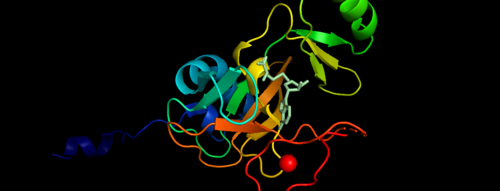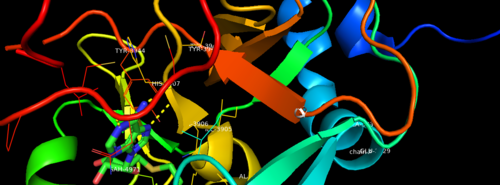User:Sumit Kamat/Sandbox Reserved 901
From Proteopedia
(Difference between revisions)
| Line 1: | Line 1: | ||
==Histone-lysine N-methyltransferase 2A KMT2A== | ==Histone-lysine N-methyltransferase 2A KMT2A== | ||
| - | <Structure load= | + | <Structure load= 2W5Y size='340' fram= true side='right' caption='Histone-lysine N-methyltransferase 2A KMT2A (PDB entry [[2w5y]])' scene=''> |
== Overview == | == Overview == | ||
| Line 7: | Line 7: | ||
| - | [[Image:|thumb| | + | [[Image:2w5y ligand.png|thumb|500px|center|.Figure Showing the Binary Complex of the Mixed Lineage Leukaemia (MLL1) SET Domain with the cofactor product S-Adenosylhomocysteine.]] |
== Function == | == Function == | ||
| Line 13: | Line 13: | ||
The KMT2A gene encodes a protein which is contains multiple conserved domains. KMT2A gene encodes a transcriptional coactivator that plays an important role in regulating gene expression during early development and hematopoiesis. Out of the many domains, SET domain is responsible for its histone H3 lysine 4 (H3K4) methyltransferase activity which mediates chromatin modifications associated with epigenetic transcriptional activation <ref> PMC 3225774 </ref>.The SET1 and MLL (KMT2) methyltransferases are conserved from yeast through humans. The Saccharomyces cerevisiae genome encodes a single H3K4 methyltransferase, Set1, whereas humans possess at least six homologs: SET1a, SET1b and MLL1-4. Unlike many SET domain enzymes, SET1 and MLL KMTs display very weak activity toward H3K4 and require additional subunits to attain maximal activity <ref>PMC3711867</ref>. MLL1 was found to be involved in chromosomal translocations in a variety of acute lymphoid and myeloid leukaemias <ref> Eissenberg JC, Shilatifard A. Histone H3 lysine 4 (H3K4) methylation in development and differentiation. Dev Biol. 2010 Mar 15;339(2):240-9. doi: 10.1016/j.ydbio.2009.08.017. Epub 2009 Aug 21. PMID: 19703438; PMCID: PMC3711867 </ref>. | The KMT2A gene encodes a protein which is contains multiple conserved domains. KMT2A gene encodes a transcriptional coactivator that plays an important role in regulating gene expression during early development and hematopoiesis. Out of the many domains, SET domain is responsible for its histone H3 lysine 4 (H3K4) methyltransferase activity which mediates chromatin modifications associated with epigenetic transcriptional activation <ref> PMC 3225774 </ref>.The SET1 and MLL (KMT2) methyltransferases are conserved from yeast through humans. The Saccharomyces cerevisiae genome encodes a single H3K4 methyltransferase, Set1, whereas humans possess at least six homologs: SET1a, SET1b and MLL1-4. Unlike many SET domain enzymes, SET1 and MLL KMTs display very weak activity toward H3K4 and require additional subunits to attain maximal activity <ref>PMC3711867</ref>. MLL1 was found to be involved in chromosomal translocations in a variety of acute lymphoid and myeloid leukaemias <ref> Eissenberg JC, Shilatifard A. Histone H3 lysine 4 (H3K4) methylation in development and differentiation. Dev Biol. 2010 Mar 15;339(2):240-9. doi: 10.1016/j.ydbio.2009.08.017. Epub 2009 Aug 21. PMID: 19703438; PMCID: PMC3711867 </ref>. | ||
| - | [[Image:Binding Pocket.png|thumb| | + | [[Image:Binding Pocket.png|thumb|500px|center|Figure 1. Binding Domain pocket of KMT2A SET Domain with the cofactor product S-Adenosylhomocysteine. |
]] | ]] | ||
Revision as of 17:26, 28 April 2020
Histone-lysine N-methyltransferase 2A KMT2A
| |||||||||||


